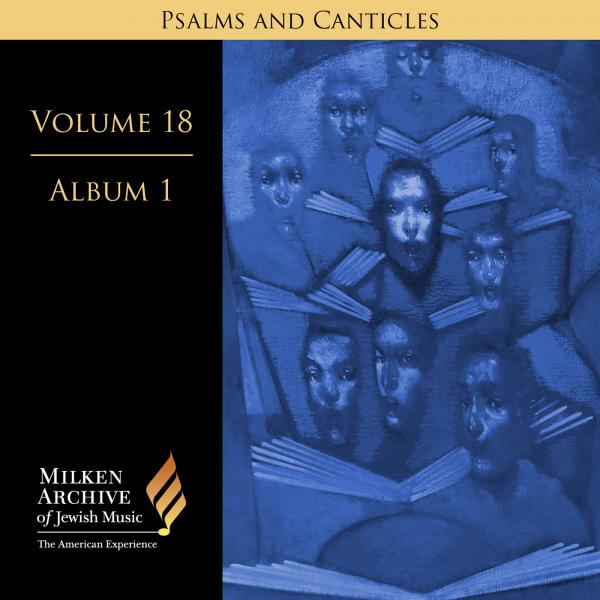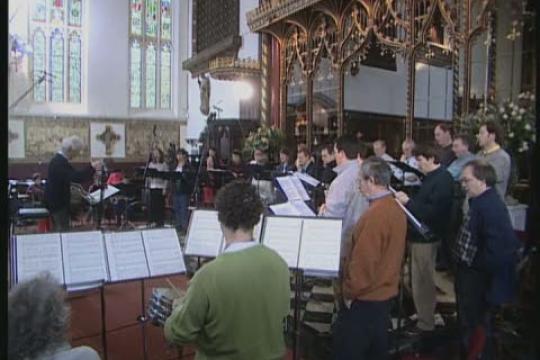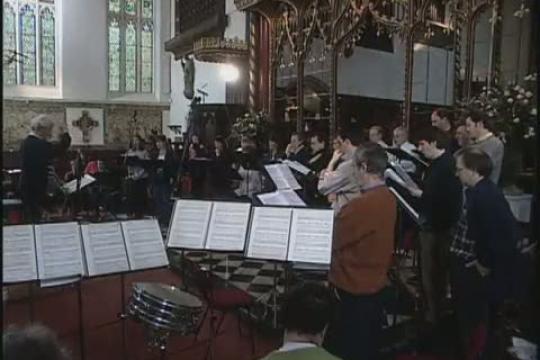Tracks
Liner Notes
Danse de Salomé (Op. 61) is one of Achron’s most original—and least known—compositions. As a wordless choral work that, by the composer’s design, uses the chorus to imitate specific orchestral instruments through various choral effects, timbres and timbral affectations, and isolated as well as repeated syllables, the preface to the published edition states that it seems to be the first use of this technique. Considering the entire range of extant choral literature, it is probably safer to say that it is one of the first. The chorus, which is divided into five parts and accompanied only by percussion, is designated a “vocal orchestra” in the score.
Achron used as thematic material motifs from two melodic phrases of undetermined origin but probably of great age—which he heard sung in 1924 by the Samaritans when he witnessed their unique Passover sacrificial ceremony on Mount Gerezim in Palestine. The first of those themes is—as employed by Achron—a brief, catchy motive, in which the modality is altered after the first three pitches, repeated internally and sequentially at the interval of the fifth; the second is a slower-moving, more chantlike phrase.
The Samaritans: Origins, Beliefs, and Practices
The Samaritans are a cult or sect whose beliefs and practices, as well as early history, are related to Judaism inasmuch as they accept the “written Torah” (viz., the Pentateuch, or the Five Books of Moses) as their foundational text but, except for the Book of Joshua with many variations, without the other two parts of the Hebrew Bible—the n’vi’im (the Prophets) and the k’tuvim (Sacred Writings)—and without the accompanying body of subsequently accumulated “oral law,” i.e., the Talmud and the other supporting commentaries basic to rabbinic Judaism. Samaritan tradition teaches that their line extends back to the ancient Israelites, the split occurring during the time of Eli the Priest (the teacher of the prophet Samuel).There are references as early as the Book of Kings, however, that suggest their origin either as Assyrian immigrants who were imported to the former Northern Kingdom of Israel or as a mixture of those immigrants with native northern Israelites.
Although the Samaritans reject the authority of the Talmud and the other subsequent components of rabbinic Judaism, their tradition, unlike literalist sects such as the Karaites, is not without its own interpretive apparatus. They posses their own non-rabbinic tradition of interpretation, commentary, and writings based on the Torah.
From modern scholarly and scientific perspectives, the various theories about the origin of the Samaritans all suggest their connection ab initio to the same monotheistic “cult of the tetragram” in the land of Israel that also embraced the Israelites who eventually developed the religion that became Judaism. The Samaritans’ version of the Torah—the Samaritikon, which their tradition dates to the time of Moses—has slight and, by most accounts, insignificant variances from the Masoretic text of Judaism (as many as six thousand instances, by some calculations), which are ascribed either to scribal error or deliberate alteration. Samaritan tradition maintains that their Samaritikon (which was quoted by Jerome and Eusebius in the 4th century) was copied by Avishua ben Pinkhas (Abissa ben Phineas) shortly after entering the land of Canaan, and is therefore the original and authoritative text. Modern literary-biblical criticism and objective scientific analysis, however, do not support that contention—not least because the similarity between the two texts is accepted as suggesting that they have a common identical source. It is true that a debt to northern Israel is acknowledged for some traditions and sources that were incorporated into Judaism and into its primal text. Modern scholarship, however, has identified the southern region, Judea, as the geographical and cultural base of the development of the sacred texts that culminated in the Hebrew Bible.
The Samaritans are so called historically because they inhabited Samaria and its region after the fall of the Northern Kingdom to the Assyrians in the 8th century B.C.E. The ancient Samarian temple was built in 332 B.C.E. on Mount Gerezim, near Schechem (modern Nāblus), which has biblical-geographic roots as early as the Book of Genesis. That temple was destroyed near the end of the 2nd century B.C.E. by John Hyrcanus, but it was rebuilt by the Romans after the Bar Kokhba revolt—only to be destroyed again in 484 C.E. Throughout their history the Samaritans have resided primarily in or near this area (and in Ḥolon), where they continue their way of religious life to this day—with an estimated population of about five hundred at the end of the 20th century. In the past, there have also been secondary Diaspora Samaritan communities.
According to some not uncontested accounts, the Samaritans considered themselves descendants of the Ephraimites (the Israelite population of the hill country surrounding Shechem in the Northern Kingdom), who, in the Book of Kings (I Kings 12:16) following Solomon’s death, declare their separation from Judah and the Davidic line: “What portion have we in David? Neither have we inheritance in the House of Jesse.” II Kings (17: 23–24). The only reference to the Samaritans by that name (shomronim) in the Hebrew Bible is in II Kings (17:29), which describes their origin as a separate religious group and their 8th-century B.C.E. mode of worship. Later, when they asked to participate in the restoration of the Temple in Jerusalem following the Babylonian captivity, their offers were rejected as having come from “the enemies of Juda” (Ezra 4:1–3). Thus the Samaritans do not regard Jerusalem as the holy city or center; that status is reserved for Mount Gerezim.
From the perspectives of rabbinic Judaism, the Samaritans’ religious beliefs and practices are sometimes inaccurately viewed as an early tributary form of Judaism that is now fossilized as a pre-rabbinic system. But Samaritan theology, historical traditions, practices, and interpreted adherence to the legal provisions of the Torah have indeed been subject to evolution and development over the centuries, through their own non-rabbinic procedures, sources, and rulings. In 1949, in fact, they were recognized as citizens of Israel under the Law of Return—which provides for the right of all Jews to become citizens. Samaritans serve in the Israel Defense Forces (IDF), and their obligation to do so as citizens was established following the Six Day War, in 1967. In 1954 a unified Samaritan center was founded in Israel, and in 1963 President Ben-Zvi dedicated the first Samaritan synagogue there.
The Samaritans have sometimes been called “the oldest continuously existing heretical Jewish group”—a description actually found in some encyclopedia entries and similar secondary sources. That designation, or course, stems from the Samaritans’ reliance on the Pentateuch without the specifically rabbinic interpretive tradition as the codified and canonized system of oral law that informs historical Judaism. But such lingo, though probably innocently employed, seems inappropriate and misleading in view of both of the Samaritans’ own interpretive traditions and of the dangerous connotations of “heresy” and “heretic” in Western history. The Samaritans have retained a priesthood, both ceremonially and as arbiter-interpreter of the law in place of Judaism’s rabbinic system; and they perpetuate sacrificial rituals. The most widely known among such ancient public ceremonies is their sacrifice of the paschal lamb on Mount Gerezim on the eve of Passover—a colorful nightlong event that has received considerable outside attention in recent decades, and which was recorded in 1971 by a landmark documentary film produced by the ethnomusicologist Johanna Spector.
The ceremony is conducted at dusk on the fourteenth of the month of Nissan at a site about eight hundred meters from the mountain’s summit, near a Samarian residential area. The entire community is divided into two groups, assembled at the altar. One accomplishes the actual sacrifice while the other—priests and other communal leaders—engages in prayer. The high priest ascends a large rock and, while reciting the biblical account of the exodus from Egypt, signals the first group to prepare for slaughter the sheep that have been brought to the site. During that procedure, vocal communal prayer is heard. After the slaughter has been approved in terms of compliance with the laws of kashrut, the wool is removed from the sheep, and their intestines—together with those parts of the animals that are inedible according to the laws of kashrut—are cleaned and burned on the altar. After ritual cleaning and kashering (being salted to absorb the blood), for which two hours is set aside, the sheep are placed on spits and carried to pits that have been dug into the ground to serve as ovens. They are roasted for more than six hours, until, at midnight, the people return with bowls or similar vessels. The roasted sheep are removed from the earthen ovens and the meat divided and placed in each of the bowls for the people to take home. There, they consume the “sacrifice” with matza and morror (bitter herbs). Any meat left unconsumed is brought back to the altar and burned. The entre ritual is accompanied not only by vocal prayer intonations with chantlike character, but also by singing and movement.
Samaritan Musical Tradition and Danse de Salomé
Achron witnessed this remarkable ceremony on his visit to the Samaritan Pesah celebration in 1924, when he was living in Palestine. And it was then that he made note of the two melodies he used in Danse de Salomé.
Prominent features of Samaritan musical tradition, which is entirely a capella, include a sharply syllabic delivery for texts, within a limited pitch range; another, nonsyllabic style that emphasizes ornamentation; an almost deliberate wavering of pitch as a type of vibrato; strong, clipped sforzando-like accents at high volume; melodic extensions by added syllables (or “filler syllables”); and wide glissandi. Achron has reflected all of these in this work. The rapid syllabic repetitions (on predetermined syllables) specified in the score are highly effective and are developed in creative ways. The glissandi, which occur at various points—sometimes in subtle gradations leading to or from particular pitches—are especially prominent at the end of the piece. And he has infused the whole with ingenious counterpoint that never predominates or obscures the clarity of textures and the open intervals.
Another important element of Samaritan tradition is a type of parallel organum, said to be accomplished spontaneously in actual Samaritan practice. But Achron has employed it quite deliberately in several passages.
Why Salomé?
The appearance in the title of the New Testament character Salomé, however, is both curious and mysterious, since no such character is part of any Samaritan ritual or tradition.
The Gospels of Matthew (14:6–11) and Mark (6:21–29) refer to Salomé and to the incident with which she is infamously associated—but not by name. In these accounts, Salome—who is named by the 1st-century Jewish historian Josephus (Jewish Antiquities, Book XVIII)—demands and achieves, on instructions from her mother, the death of John the Baptist. She is the daughter of Herodias, who “divorced herself” from her husband (Salome’s father), Philip (Herod Philip). After her “divorce,” Herodias married Herod Antipas, the half brother of her former husband, Herod Philip. (Neither Herod Philip nor Herod Antipas should be confused with the Roman tetrarch Herod the Great.)
John the Baptist had severely chastised and condemned Herod for marrying his half brother’s wife (in Mark, Philip is cited simply as Herod’s “brother”). Urged by Herodias, or to pacify her anger (“for the sake of Herodias” in the English translation of the Revised Standard Version), Herod Antipas ordered John the Baptist imprisoned, but Herodias remained outraged (“had a grudge against him [John the Baptist] and wanted to kill him”). The opportunity for revenge came when Salome danced for Herod Antipas at his birthday banquet. He was so pleased (or seduced) by her dancing that as a reward, he offered to grant her any request she might make. When she consulted with her mother, Herodias told her to demand the head of John the Baptist. When she relayed that request as her own to Herod Antipas, he felt he had no choice but to honor his word—especially in front of his guests—and he regretfully had John the Baptist beheaded, had the head brought to him, and gave it to Salome, who gave it to her mother.
One can only speculate that Achron used the name if not the image of Salome here in the most liberal sense—with reference not to the specific New Testament incident, but to the aura of sensuousness that is evoked not only by her very name and by imagining the details of her dancing for Herod, but also by her famous “dance of the seven veils” in Richard Strauss’s opera Salome. And although dance is not a specific art or folk-art parameter of the Samaritan sacrificial ceremony, there is a kind of unchoreographed movement inherent in it—as the ceremony proceeds and the excitement and intensity build. Perhaps Achron sought to interpret or expand this element chorally. Moreover, he obviously intuited a sensuous aspect of the ceremony and its—for him—raw echo of antiquity. This is certainly reflected in the music and the choral intensity of the piece.
Danse de Salomé was commissioned in 1925 for a concert of the Stony Point Ensemble. It was completed in October of that year and premiered the following month at the Metropolitan Opera House in New York.
Credits
Composer: Joseph AchronPerformers: BBC Singers; Avner Itai, Conductor


